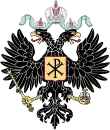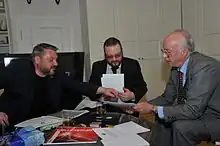Romanov Empire (micronation)
The Romanov Empire (Russian: Романовская Империя[1][2]), also known as the Imperial Throne (Russian: Императорский Престол[3]), formerly the Russian Empire (Российская Империя), is a state proposed by Russian businessman and politician Anton Bakov as a re-creation of the Russian Empire. It would be led by Romanov heir Prince Karl Emich of Leiningen as Emperor Nicholas III, with Bakov serving as Archchancellor. As of 2023, no concrete action has taken place to establish such a state.
Romanov Empire Micronation | |
|---|---|
 Flag
 Coat of arms
| |
| Organizational structure | Micronation |
Website http://romanovempire.com/en/ | |
Bakov declared the new Russian Empire to be the successor to the historical Russian Empire that ceased to exist in 1917.[4] Bakov declared himself prime minister.[5] In June 2012, Bakov registered the Monarchist Party with the Russian Ministry of Justice,[6] with a stated goal of restoring the monarchy to Russia in accordance with law. It is the only legalised monarchist party in Russia. In the fall of 2013, Bakov's daughter Anastasia Bakova (Анастасия Бакова) was the Monarchist Party's candidate in the mayoral elections in Yekaterinburg.

On 31 March 2014, under the new name of the Imperial Throne, the micronation issued a manifesto announcing itself a sovereign nation and declaring that Prince Karl Emich of Leiningen (born 1952) had become its head with the title of Nicholas III, Emperor of All Russia, as a successor to Nicholas II. After he was named Emperor, Nicholas III wrote a letter to Vladimir Putin requesting land in Yekaterinburg to establish a capital with its own imperial senate.[7] The request was denied.[8]
In 2020 Bakov declared that his new project, successor to the Empire, entitled Arca Noë is going to be based in neutral Mediterranean waters close to Venice as a part of Seasteading movement.[9]
References
- "Закон "О равнозначности наименований Суверенное государство Императорский Престол и Романовская Империя"". Russianempire.org. Archived from the original on 3 November 2017. Retrieved 30 October 2017.
- Устинов, Александр. "Принят Закон "О равнозначности наименований Суверенное государство Императорский Престол и Романовская Империя"". Rupolit.net. Archived from the original on 7 November 2017. Retrieved 4 June 2018.
- КОНСТИТУЦИЯ СУВЕРЕННОГО ГОСУДАРСТВА ИМПЕРАТОРСКИЙ ПРЕСТОЛ [Constitution of the Sovereign State of the Imperial Throne]. Russianempire.org (in Russian). Archived from the original on 18 April 2015. Retrieved 30 January 2015.
1. Императорский Престол – Суверенное Государство, конституционная монархия, правопреемник Всероссийского Императорского Престола, и предшествовавших ему Римского и Византийского Престолов
- "About". Russianempire.org (in Russian). Archived from the original on 31 December 2014. Retrieved 30 January 2015.
- Возрождена Российская империя [Revived Russian Empire]. Babr (in Russian). 2 September 2011. Archived from the original on 18 October 2016. Retrieved 30 January 2015.
- "Список политических партий, имеющих право в соответствии с Федеральным законом от 11.07.2001 № 95-ФЗ «О политических партиях» принимать участие в выборах | Минюст России". minjust.ru. Archived from the original on 28 September 2013. Retrieved 12 January 2022.
- "Политическая инициатива Николая Кирилловича, Принца Лейнингенского, по созданию в Екатеринбурге города-государства – Императорский Всероссийский Престол". Monpartya.ru. Archived from the original on 29 November 2014. Retrieved 31 March 2015.
- Гость "Стенда"– Антон Баков, Председатель Монархической партии России [Guest Anton Bakov, President of the Monarch Party of Russia]. Channel4 (in Russian). 2 June 2014. Archived from the original on 9 October 2014. Retrieved 30 January 2015.
- "Антон Баков хочет построить новое государство "Ноев ковчег" рядом с Венецией". Archived from the original on 19 July 2021. Retrieved 29 April 2020.